
Today, a tribute to the two men who made it happen. No, not Avery or Clampett, Jones or Freleng… Schlesinger and Selzer. Leon Schlesinger was he original man behind Warner Bros. Cartoons and their first producer. Here is Leon’s official studio biography from 1939:


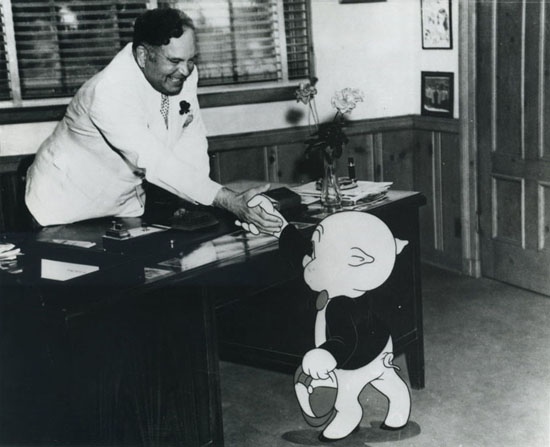
Leon sold his cartoon studio to Warner Bros. in July 1944, and he became an executive with the studio – the first to concentrate on merchandising the Looney Tunes characters. He passed away the day after Christmas on Christmas day in 1949.
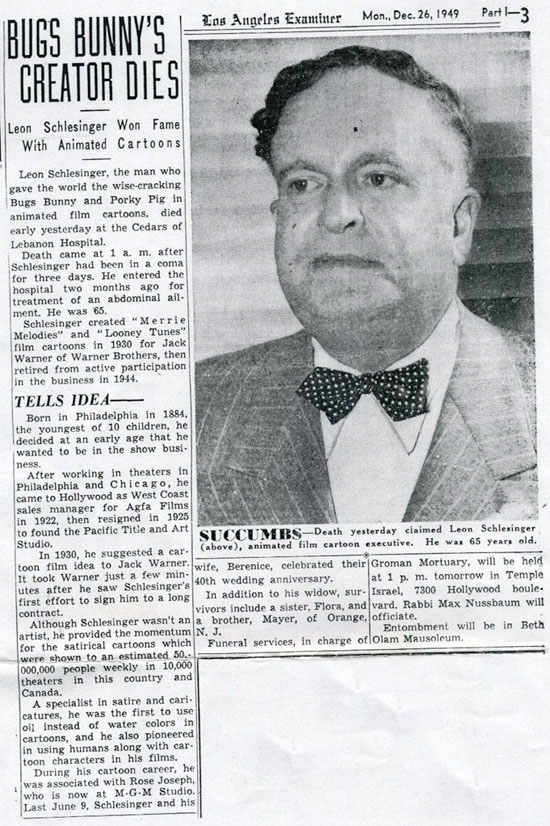
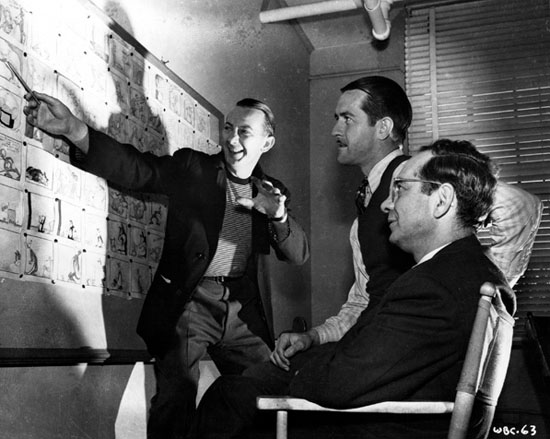
Edward Selzer (above, seated – with Warren Foster and Robert McKimson) was notorious for his lack of a sense of humor. Selzer was installed as the cartoon studio producer, Leon’s replacement, in July 1944. Here’s his official studio bio from 1956.
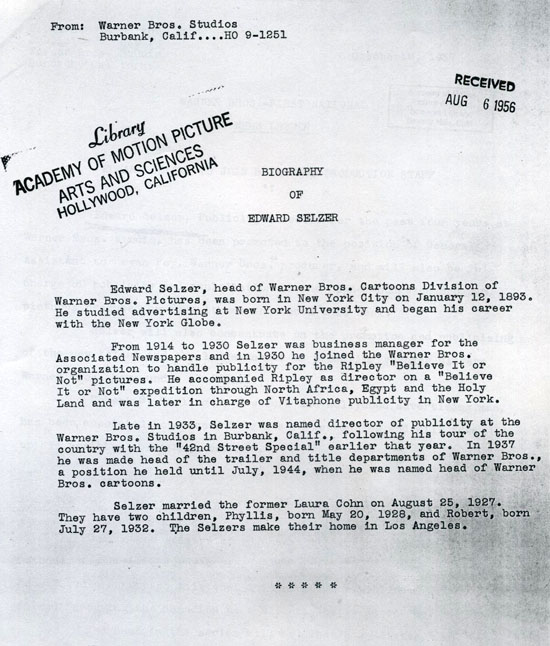
He retired in 1958 – Here’s how Variety reported it:
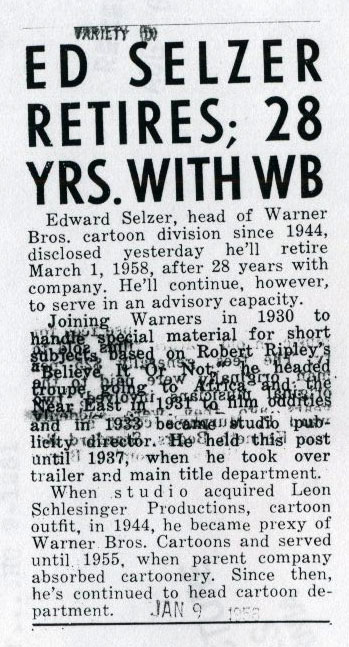
Selzer passed away in 1970. Here’s his Hollywood Reporter obit:

Neither man could draw; and there are strong doubts they had any idea how an animated film was produced. But both allowed their artists to be artists; they gave their crews the creative freedom to create what would become masterpieces of animated comedy – even if they didn’t realize that’s what they were doing.
I don’t care what anyone thinks – Schlesinger and Selzer, I salute you!


 Jerry Beck is a writer, animation producer, college professor and author of more than 15 books on animation history. He is a former studio exec with Nickelodeon Movies and Disney, and has written for The Hollywood Reporter and Variety. He has curated cartoons for DVD and Blu-ray compilations and has lent his expertise to dozens of bonus documentaries and audio commentaries on such. Beck is currently on the faculty of CalArts in Valencia, UCLA in Westwood and Woodbury University in Burbank – teaching animation history. More about Jerry Beck [
Jerry Beck is a writer, animation producer, college professor and author of more than 15 books on animation history. He is a former studio exec with Nickelodeon Movies and Disney, and has written for The Hollywood Reporter and Variety. He has curated cartoons for DVD and Blu-ray compilations and has lent his expertise to dozens of bonus documentaries and audio commentaries on such. Beck is currently on the faculty of CalArts in Valencia, UCLA in Westwood and Woodbury University in Burbank – teaching animation history. More about Jerry Beck [



































Agree. Always felt they sound like a dream compared to what is called a producer today. They nipped at heels and made sure things were on time ,on budget ,quotas were met and the films made money. That’s what seemed to matter to them but they at least allowed their teams to create and discover the recipes for success and failures.
Clampett, Avery and several others spoke of what a good boss Schlesinger was, in contrast to Chuck Jones’s often unpleasant or downright snobbish summations. There is so much we still don’t know about the day-to-day operations there. The fact that Hawley Pratt called Friz the spark plug of the whole studio, and the one with the political power whom Schlesinger always respected, is a whole unexplored area, and it strikes me that the somewhat elitist nature of certain more “arty” people (Jones, Hugh Harman, Shamus Culhane) couldn’t tolerate the slightly cruder and more extrovert, confident types like Leon and Ben Hardaway. They would boost their confidence by using the excuse that Leon couldn’t draw, so what would he know? Well he was already a success before he joined with Harman & Ising in late ’29, when most of his future staff were still in school. And he was a natural showman who understood show biz, audiences and the hard-nosed business world, and he probably intimidated the young Jones, who forever after spread often silly stories about Leon into early cartoon history. The indisputable fact is that Leon, for a non-pro, was excellent in YOU OUGHT TO BE IN PICTURES and could have played character bits in WB features. There’s even a whole case for Selzer, who was admittedly not the show pony Schlesinger was…but lack of humour or not, there’s more to him too. WB layout man Pete Alvarado once told Amid Amidi that Selzer was a very nice and thoughtful man, and praised him as a boss. Far from the troglodyte painted once more by Chuck, who in hindsight often comes across as a most unhappy curmudgeon. I’d love to know if there are grandkids of both bosses still around who might add to our knowledge.
I agree with Keith. An examination of the day-to-day operations of the Schlesinger/Warner studio is direly needed. Mike Barrier’s Warner chapters are the closest and best we have, but he says almost nothing about Freleng, Tashlin, McKimson, and Davis, other than their inferiority to Jones, Clampett, and Avery. It’d be great to have something more in-depth to call upon.
(To be quite honest, though, Ben Hardaway’s rep as a storyman and director says that anyone’s criticism of his skill is quite apt.)
It wasn’t just Jones who disliked Selzer…. Bob Givens has said Selzer “hated cartoons” and repeated the story of Selzer saying, “What’s so funny about making cartoons?” Lloyd Turner and Bill Scott have also recalled Selzer being an unpleasant person; Scott referred to Selzer as a “mean, old man”. Why do you say it was just Jones who hated Selzer?
Hiya! i’m one of those grandkids; Eddie is my great-grandfather. 😁
Hi Keith,
I’m Eddie’s granddaughter. Chuck’s family was actually very good friends with ours and even at his funeral the family made it a point to state he DID respect my grandfather, and vice-versa, and knew be owed a lot to both men. He was a temperamental artist but also incredibly kind to our family.
🙂
Jerry, any idea what the Selzer obit is saying when it notes “He was president of the company’s cartoon subsidiary from 1944 until the subsidiary was dissolved in 1955.” Typo on the obit, or did WB do some sort of reorganization in ’55 like Paramount did a year later when it dissolved Famous Studios?
In 1955, Warner Bros. Cartoons Inc. a stand-alone subsidiary was absorbed into the main company Warner Bros. Pictures. Inc. – the same year the studio was moved onto the main lot in Burbank.
It’s funny how people like Schlesinger and Selzer, who had little to no animation experience, ran tighter ships and held onto talent longer than guys who had been animators and directors (i.e. Max Fleischer, Walter Lantz and Paul Terry)
I think these guys provided the resistance that the excellent artists needed to be able to make the cartoons they made – the energy, the antagonism, the cleverness of Looney Tunes and Merrie Melodies speaks to the pressure those guys were under to make art, and make it quick. I think when left to their own devices, artists (and I’m speaking as one) tend to fuss over their work endlessly, which robs it of spontaneity and energy. So at the very least, Schlesinger and Selzer ran a tight ship and hired the right guys for the job, and gave the artists an immovable object to meet their irresistible force.
Oh yes. I think about certain modern legendary animators (no names mentioned) who will moan about their times producing for a studio yet when they attempt independence, their work sinks or is not as entertaining.
Perhaps proof that it is never one artist who is the author of a success, even though he or she has top-billing, but the chemistry of the dynamics of mix of individuals at a certain time and certain place which may never be replicated again.
“The Life and Death of Looney Tunes Producers: Schlesinger and Selzer | Cartoon Research” was a
wonderful blog post, can not help but wait to examine even more of ur blog posts.
Time to squander a little time on the internet lol.
Thanks for the post ,Sherry
Great post Jerry!
It’s interesting to see how Schlesinger’s/Warners was so similar to MGM in regards to the obliviousness of the managers. Fred Quimby wasn’t too up on the comedy or the animation either, all he was concerned about was getting a picture out on time and on budget. Such a policy worked wonders!
A real shame these kinds of producers have long departed from the animation scene.
I agree, Jerry. Seems Leon and Selzer (as far as I know) did not ride herd on the artists as happened at other studios. If forced to pick only one moment to thank them for, it’s the final gag in Frank Tashlin’s I’ve Got Plenty Of Mutton. Comedy writers strictly operating on Level 1 would have the crazed ram tear off his costume and reveal a wolf at the end of the cartoon – he doesn’t and the 1944 censors were too dumb to get the joke.
Minor nit: The Schlesinger obit shows he died on Christmas day, not the day after; it was published on the 26th, and says he died “early yesterday”. Given deadlines and such of the era, I very much doubt 1 AM would have made the deadline for the same day’s paper. The California Death Index (at Rootsweb.com) concurs, as does his death marker.
Point taken! Thanks Jon!
One oft-told story by Jones that I have always wondered about is how “Bully for Bugs” was made. According to Jones, one day Eddie Seltzer said that there was nothing funny about bulls, and the WB animators should never make a cartoon about bulls. Since the whole cartoon department knew that Seltzer was always wrong, they made “Bully for Bugs”, with Bugs as a bullfighter, and it was a big hit.
Now, can anyone imagine Walt Disney telling his animators not to make cartoons about a particular subject, and them immediately doing so? Disney would have fired them all. Disney would have probably fired them before the cartoon was even finished, because he did keep track of what his animation units were working on. Jones’ story does not make sense even as an illustration of how clueless Schlesinger and Seltzer were, since Seltzer was bound to learn of “Bully for Bugs” after its release.
I wonder how Jones would have kept Bully for Bugs a secret, as I understand cartoons were in production for a total of 6 months at Warners, from storyboard to final print.
As the studio was only producing about 15 minutes worth of animation per month at that time, how would Seltzer not have seen this during the various phases of production? Was he not paying any attention to what the artists were drawing?
I think it was my grandmother who told me Grandpa Ed’s statement was “A bull and a bunny aren’t funny” and that alone was hilarious to the artists. If it wasn’t grandma it may have been Chuck’s wife who mentioned it at his WB memorial service (sorry, it’s kind of a blur, grandma and Chuck passed somewhat close together and a lot of old stories were being shared around that time).
I believe what my grandfather said was actually, ‘A bull and a bunny isn’t funny!’, which led the entire team to bust out laughing and more determined to prove him wrong.
I’ve read many things about Schlesinger, and all of them paint a picture of a brilliant businessman who also had a sense of humor. Some of the things Chuck Jones said about him were snarky, but I get the idea that Schlesinger was sarcastic and had a big ego…and Jones, (who was also sarcastic and egotistical) may have taken some of Schlesinger’s interactions with him the wrong way. Tex Avery and Bill Melendez and Martha Sigall all had nice things to say about him, and there is unarguable evidence that he threw the best Christmas parties any Jewish guy could ever throw. Most of all, he left his artists alone, and he didn’t care HOW they did their work as long as they did it on time and on budget…and threw in lots of jokes. Sounds like a good guy to work for to me!
Selzer, conversely, sounds like a real stick in the mud. It also seems clear that he eventually lightened up and admitted defeat, and that if he left his talent alone, they made cartoons he could take credit for at the Oscars. And he kept the ship afloat for, what, 15 years? You have to at least give him that!
Anybody who’s seen the studionChristmas party movies on the last Golden Collection DVD would also agree with what you say about Schlesinger: he shows a real sense of fun and and self-kidding on those films.
The thing I’ve made a point of in the past when it came to the “Schlesinger didn’t know cartoons” line was that sometime at the end of 1935, someone at the studio — Leon, Henry Bender or Ray Katz — made the decision to leap-frog the Tex Avery unit over the Jack King unit, and assign Avery to help Friz Freleng with the output of the color Merrie Melodies.
King was an ex-Disney artist who would be taken back by Walt (I guess he must have loved the style of “Shanghaied Shipmates”) and was the main director of the Donald Duck series for a decade. So the ‘safe’ choice would have been to promote King’s unit to share the color cartoon duties and leave Avery & Co. in the position Clampett ended up with in the late 1930s, especially since the decision was made after Tex had directed, at most, two B&W Looney Tunes. So it wasn’t just hiring people and leaving them alone, it was also knowing which people to promote. Other than the failed Hardaway-Dalton unit (which still wasn’t a total failure), and Norm McCabe’s B&W LT unit in the 40s, all of Leon’s personnel decisions from 1935 on were right. He probably never did as well in the payday poker games.
This is something I’ve often wondered about, too. The casting & promotions at this studio was really well done. It doesn’t seem to have been just promoting on seniority, as may have happened elsewhere.
A book I have on the films of Georges Melies credits Leon Schlesinger with preserving a number of Melies films. Warner Bros. discovered the prints in their vaults at some point and were planning to junk them. Schlesinger bought them from Warner Bros. and later donated them to the AMPAS. Film buffs owe Schlesinger that, too.
I take all Jones stories and accounts with a grain, if not a brick, of salt. They tend to be apocryphal, self-serving and/or “embellished”…
Here are a few snippets about Ed Selzer: http://tralfaz.blogspot.com/2011/11/edward-selzer.html
It should probably also be noted that, as far as I know, Schlesinger’s may have been the only major cartoon studio of the 1930s – 1940s that did not suffer a serious strike over employee unionization. If I remember correctly, the lockout by management only lasted six days before Schlesinger acceded to the union and, so far as I know, he never engaged in any kind of retribution against the union activists. They, in turn, stayed at Schlesinger’s and most went on to do their best work there afterwards.
As far as I know, there was never a strike against Walter Lantz Productions as an independent company, though the Lantz unit was included in an early 30’s strike against Universal itself when it was operating as a department of the main studio.
I’ve always felt that, while not an artist, Leon Schlesinger was one hell of a personnel man; who recognized and promoted up-and-coming talents whenever he saw them, and unlike Disney and his “nine old men,” had not oversold themselves on the idea of corporate loyalty, and allowed “prodigal sons” to return on good terms, as Friz Freleng did after his stay at MGM.
Selzer doesn’t sound at all as bad as Chuck interpreted…Greg Duffell mentioned that he praised Ken Harris’ animation on SCAREDY CAT…as it was as though it was the only time Harris was acknowledged.
The Schlesinger bio makes one teeny tiny error. “Old Glory” was not Porky’s first appearance in color. His first appearance in color (two-strip Technicolor, but color nonetheless) was his first appearance anywhere: “I Haven’t Got A Hat”.
two facts, 1: Leon Schlesinger’s last cartoon was Buckaroo Bugs, 1944, directed by Bob Clampett
and 2: Eddie Selzer’s last cartoon was Whoa, Be Gone, 1958, directed by Chuck Jones
Leon Schlesinger was a better executive than William T. Orr. Warner Bros. cartoons from the late 1930’s onward have stood the test of time better than the Warner Bros. television shows of the late 1950’s. Those shoes(especially 77 Sunset Strip, Cheyenne, and Maverick)have retained a certain nostalgia, however and should be considered a collective cult.
One thing the Schlesinger obit failed to mention was that he also produced six B-westerns in the early 30’s at WB that starred John Wayne, and they are pretty good.
Yeah, I don’t know that he was necessarily a good guy to work for.
I had occasion to talk with Chuck Jones a couple of times over the years, and once the discussion turned to working for Leon Schlesinger. One story: ‘Leon had a throne set up at the back of the screening room where he’d sit to review the complete shorts from the various WB directors. When he was ready he’d instruct the projectionist to, “Roll the garbage.” ‘
Needless to say, the directors and the animators were not all that fond of Leon. Chuck’s take was Leon’s nastiness might have stemmed from the idea that he really wanted to be a Warner Bros. movie producer, but somebody at the studio was most likely standing in the way of that – perhaps he was the victim of his own success, with the popularity of the Looney Tunes franchise the studio wanted him right where he was.
If you’re ever wondering what Leon’s voice sounded like, you can just reference Sylvester the Cat. In a subtle act of revenge, Chuck conspired with Mel Blanc to mimic Leon’s voice for the neurotic cartoon cat, and Leon never caught on. In fact after the very first screening of this new character, Leon, literally in tears and in a rare show of support exclaimed, ‘Where did you get that ridiculuth voi-th!? Whatever you do, make more cartoonth like that!’
You are 100% right… IF Chuck Jones is a reliable narrator of history
Unfortunately, he is a well-known grudge-driven promulgator of anecdotal, unsupportable, ahistorical crap.
Nice that you got to talk to him, though.